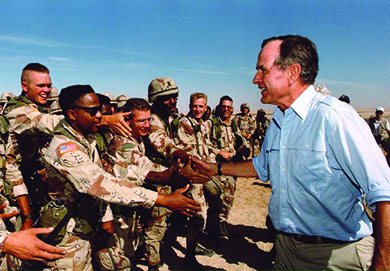| << Chapter < Page | Chapter >> Page > |

Visit the Frontline site to read first-person accounts of U.S. soldiers’ experiences in Operation Desert Storm and view weapons used in battle.
Some controversy arose among Bush’s advisors regarding whether to end the war without removing Saddam Hussein from power, but General Colin Powell, the head of the Joint Chiefs of Staff, argued that to continue to attack a defeated army would be “un-American.” Bush agreed and troops began moving out of the area in March 1991. Although Hussein was not removed from power, the war nevertheless suggested that the United States no longer suffered from “Vietnam Syndrome” and would deploy massive military resources if and when it thought necessary. In April 1991, United Nations (UN) Resolution 687 set the terms of the peace, with long-term implications. Its concluding paragraph authorizing the UN to take such steps as necessary to maintain the peace was later taken as the legal justification for the further use of force, as in 1996 and 1998, when Iraq was again bombed. It was also referenced in the lead-up to the second invasion of Iraq in 2003, when it appeared that Iraq was refusing to comply with other UN resolutions.
By nearly every measure, Operation Desert Storm was a resounding success. Through deft diplomatic efforts on the international stage, Bush had ensured that many around the world saw the action as legitimate. By making the goals of the military action both clear and limited, he also reassured an American public still skeptical of foreign entanglements. With the Soviet Union vanishing from the world stage, and the United States demonstrating the extent of its diplomatic influence and military potency with President Bush at the helm, his reelection seemed all but inevitable. Indeed, in March 1991, the president had an approval rating of 89 percent.
Despite Bush’s successes internationally, the domestic situation at home was far more complicated. Unlike Reagan, Bush was not a natural culture warrior. Rather, he was a moderate, Connecticut-born Episcopalian, a pragmatic politician, and a life-long civil servant. He was not adept at catering to post-Reagan conservatives as his predecessor had been. By the same token, he appeared incapable of capitalizing on his history of moderation and pragmatism regarding women’s rights and access to abortion. Together with a Democratic Senate, Bush broke new ground in civil rights with his support of the Americans with Disabilities Act, a far-reaching law that prohibited discrimination based on disability in public accommodations and by employers.
President Bush’s weaknesses as a culture warrior were on full display during the controversy that erupted following his nomination of a new Supreme Court judge. In 1991, Justice Thurgood Marshall, the first African American ever to sit on the Supreme Court, opted to retire, thus opening a position on the court. Thinking he was doing the prudent thing by appealing to multiple interests, Bush nominated Clarence Thomas, another African American but also a strong social conservative. The decision to nominate Thomas, however, proved to be anything but prudent. During Thomas’ confirmation hearings before the Senate Judiciary Committee, Anita Hill, a lawyer who had worked for Thomas when he was chairman of the Equal Employment Opportunity Commission (EEOC), came forward with allegations that he had sexually harassed her when he was her supervisor. Thomas denied the accusations and referred to the televised hearings as a “high tech lynching.” He survived the controversy and was appointed to the Supreme Court by a narrow Senate vote of fifty-two to forty-eight. Hill, also African American, noted later in frustration: “I had a gender, he had a race.” In the aftermath, however, sexual harassment of women in the workplace gained public attention, and harassment complaints made to the EEOC increased 50 percent by the fall of 1992. The controversy also reflected poorly on President Bush and may have hurt him with female voters in 1992.
While Ronald Reagan worked to restrict the influence of the federal government in people’s lives, he simultaneously pursued interventionist policies abroad as part of a global Cold War strategy. Eager to cure the United States of “Vietnam Syndrome,” he increased the American stockpile of weapons and aided anti-Communist groups in the Caribbean and Central America. The Reagan administration’s secret sales of arms to Iran proved disastrous, however, and resulted in indictments for administration officials. With the end of the Cold War, attention shifted to escalating tensions in the Middle East, where an international coalition assembled by George H. W. Bush drove invading Iraqi forces from Kuwait. As Bush discovered in the last years of his presidency, even this almost-flawless exercise in international diplomatic and military power was not enough to calm a changing cultural and political climate at home.

Notification Switch
Would you like to follow the 'U.s. history' conversation and receive update notifications?